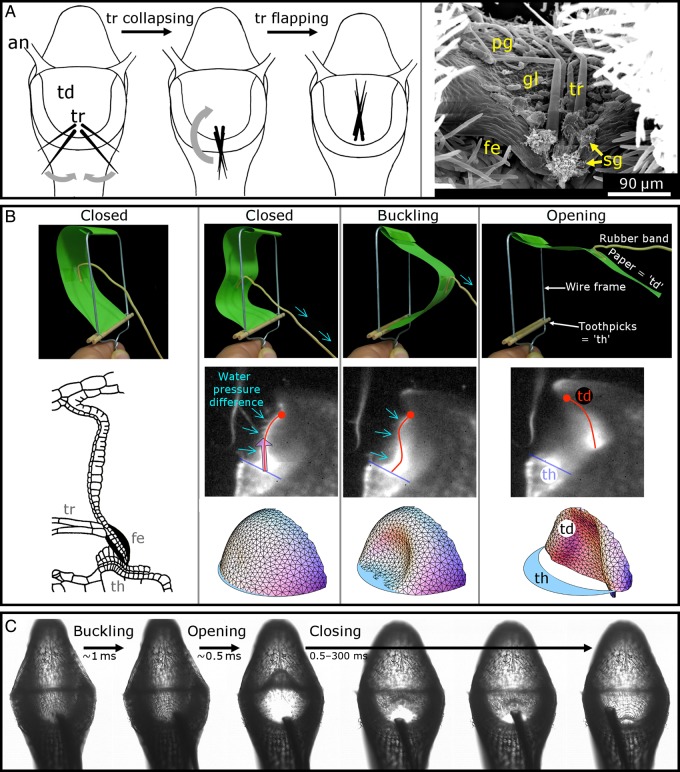Figure 9.
The trapdoor movement. (A) Frontal view of the trap entrance with ‘antennae’ (an). Schematic drawing of the collapsing and flapping motions of trigger hairs (tr) that are caused by the trapdoor (td) deformation (not shown). (B) Scanning electron microscope image of the outer trapdoor surface of U. vulgaris. The trapdoor has been manually pressed open at its lateral areas with a fine glass capillary. It can be seen that the trigger hairs have flapped onto the trapdoor surface similar as it is schematically depicted in the rightmost image in (A). Note also the free door edge (fe), spherically headed (sg) and pyriform glands (pg) as well as other glands (gl). (B) The different trapdoor movement steps are depicted. The upper images are photographs of the physical hand model proposed by Poppinga et al. (2013c). In this model, the ‘trapdoor’ does not possess a double curvature (as does the natural trapdoor), but nonetheless it can be regarded as a functional model. The schematic drawing on the left depicts the closed trapdoor in the ‘locked’ convex position and is modified from Lloyd (1932). (© Canadian Science Publishing or its licensors). The middle images are frames from high-speed recordings of a lateral view of a U. inflata trapdoor in fluorescence laser sheet microscopy. The lower images are a dynamic simulation of the trapdoor. Both series (middle and lower images) are modified from Vincent et al. (2011b). Images situated on top of each other correspond to the same movement step (indicated as closed, buckling and opening). First, on the very left, the situation shortly after firing is shown. Only little force acts against the trapdoor because the pressure difference between the inside and outside of the trap is low. As the pressure difference rises (‘simulated’ by pulling a rubber band in the hand model), so does the force that acts on the trapdoor which becomes more and more mechanically sensitive. After triggering or spontaneously (critical pressure ‘simulated’ by further pulling the rubber band in the hand model), the trapdoor buckles inside (curvature inversion from convex to concave). In this position, the friction force on the threshold (th) (‘simulated’ by gaps between the toothpicks in the hand model) is low and the trapdoor cannot resist the force exerted by the water pressure difference any longer and swings open. (C) High-speed video frames (recording speed: 10 000 fps) of a frontal view of the trap entrance of U. vulgaris during suction. The door first buckles, then swings open and then recloses much slower.

